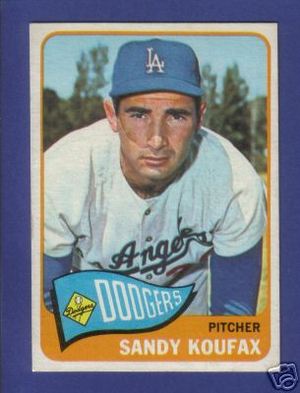Ask anyone over the age of 50 who the greatest pitcher they ever saw was and the most likely answer you will get is Sandy Koufax. A fireballing lefty with a 12-to-6 curve, Sandy Koufax enjoyed a stretch of dominance in the 1960s that was simply amazing. From 1961-1966, Sandy Koufax went 132-47. In that span, Sandy Koufax won five straight ERA titles, hurled four no-hitters, won three Cy Young Awards (each by a unanimous vote), fanned 18 batters in a game two times and was the NL MVP in 1963.
Sandy Koufax retired from the game following the 1966 season. Despite posting a 27-9 record with a 1.79 ERA, Sandy Koufax suffered from an arthritic condition in his left elbow that made pitching agonizing. Just to be able to pitch, Sandy Koufax took pills for pain and inflammation, applied ointment that was nicknamed “Atomic Balm” and soaked his elbow in a bucket of ice. Sandy Koufax retired at the peak of his career rather than continue that regimen.
In his first year of eligibility in 1972, Sandy Koufax was elected to the Hall of Fame. This came one year after nobody was elected to the Hall, when a first-ballot induction was rarely granted. The previous season, Yogi Berra, one of the greatest catchers of all-time, was on the ballot and he did not get in. Sandy Koufax got 344 votes, which was 86.87% of the total cast. Also that year, Berra and Early Wynn, who won 300 games but who did not get in until his third year of eligibility, joined Sandy Koufax as members of the Hall.
But if we knew in the 1960s what we know now about ballparks, statistics and timeline adjustments, Sandy Koufax would not be considered by anyone to be the greatest pitcher of all time.
A combination of wildness and the Dodgers’ reluctance to commit a full-time spot in the rotation kept Sandy Koufax from having his first big season until 1961, when he went 18-13 with a 3.52 ERA, which was a half-run better than the National League average.
The following season, two things happened which vaulted Sandy Koufax to the best pitcher in baseball. The Dodgers moved from the L.A. Coliseum into Dodger Stadium. Sandy Koufax went from pitching in a park with a 250-foot left field wall to one of the best pitching parks in all of baseball. And also in 1962, the National League expanded from eight to 10 teams, as the New York Mets and the Houston Colt 45s (later re-named the Astros) joined the league.
In 1961, Sandy Koufax posted the following numbers:
Home: 9-8 with a 4.22 ERA
Road: 9-5 with a 2.77 ERA
In 1962, Sandy Koufax had these splits:
Home: 7-4 with a 1.75 ERA
Road: 7-3 with a 3.53 ERA
Basically, Sandy Koufax went from a home park that added 1.50 runs to his ERA to one that subtracted 1.80 runs from his ERA. For the rest of his career, Sandy Koufax enjoyed a tremendous boost from pitching in Dodger Stadium. Check out his numbers from 1964:
Home: 12-2 with a 0.85 ERA
Road: 7-3 with a 2.93 ERA
So, in the 1960s, Sandy Koufax was an All-Star caliber pitcher based solely on his road numbers. But add in his home numbers and Sandy Koufax becomes one of the best pitchers in baseball history.
In the beginning of Sandy Koufax’s career, there were eight teams in the National League and each team played the other 22 times. With the addition of two expansion clubs in 1962, the Dodgers played the other nine teams 17 times each. So, instead of five extra games against the top teams like the Giants, Reds and Cardinals, Sandy Koufax and the Dodgers got to play New York and Houston 34 times a year.
The two expansion teams averaged over 102 losses per season from 1962-1966. Sandy Koufax posted a 29-4 record versus New York and Houston in this time frame. Versus the two expansion clubs, Sandy Koufax posted an .879 winning percentage! That dwarfs his outstanding overall winning percentage in that stretch of .770 (114-34). Take away the two expansion clubs and the winning percentage of Sandy Koufax drops 31 points.
The other thing to consider is that Sandy Koufax enjoyed his streak of dominance during the 1960s, one of the greatest pitching eras of all time. The ERAs Sandy Koufax put up in this time period are just incredible. But it is not fair to compare the ERA of Sandy Koufax to a modern star, like Roger Clemens, without adjusting for the time that each pitcher was active.
In 1965, Sandy Koufax had a microscopic 2.04 ERA. The league average was 3.54, so Koufax was 1.50 runs better than average, which is outstanding. But Roger Clemens posted a 3.63 ERA in 1996 when the league average was 5.15 – how do you compare the two?
Baseball-reference.com has a stat called ERA+, which is “the ratio of the league’s ERA (adjusted to the pitcher’s ballpark) to that of the pitcher. > 100 is above average and < 100 is below average. lgERA / ERA.”
Here are the top seasons of ERA+ for Sandy Koufax:
190 187 161 160 143
Here they are for Roger Clemens:
226 221 211 177 176
Pedro Martinez:
285 245 221 212 196
Randy Johnson:
198 196 190 184 178
Greg Maddux:
273 259 191 191 166
Sandy Koufax was a great pitcher. In addition to his statistical achievements, Sandy Koufax earns tons of credit for refusing to pitch a World Series game that fell on Yom Kippur as well as retiring instead of taking pain killers. Since his retirement, Sandy Koufax has kept a low profile, refusing to cash in on lucrative endorsements.
The combination of his statistics, following his faith, refusing to further rely on medication to prolong his career and saying no to rampant commercialization makes Sandy Koufax a tremendous person and a slam dunk Hall of Fame selection.
But the next time someone mentions Sandy Koufax as the best pitcher they ever saw, ask them when they stopped watching baseball. Because once you look at his career and place it in the proper context it becomes impossible to make that conclusion. Sandy Koufax was great. But give me Greg Maddux in 1994 or Randy Johnson in 1997 or Pedro Martinez in 2000 or Roger Clemens in 1997.



